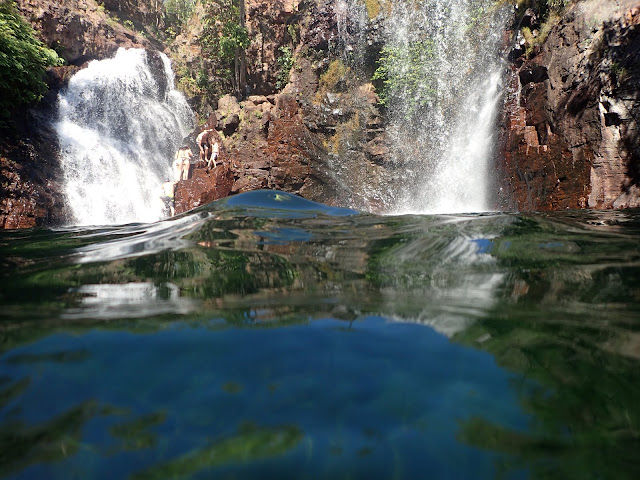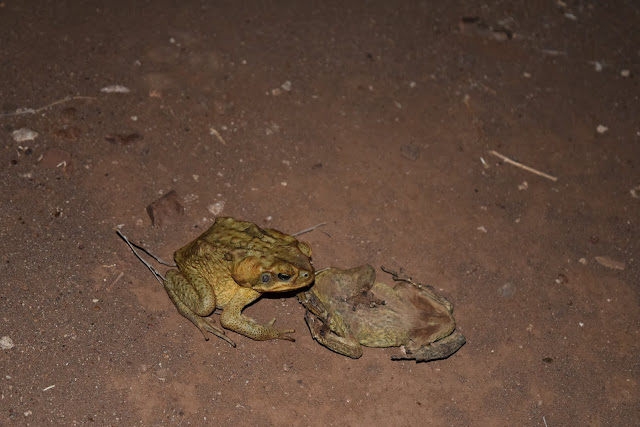Why should we care?
Data collection is complete!
It didn’t take as long as expected but I worked like a dog
and managed to get it all done with a few days to spare.
Looking at my dragons-horde pile of samples is a little
unbelievable…
 |
| There will be blood (errr, plasma) |
I’ve always been terrible at those guessing games where you
need to write down how many M&Ms, pennies, etc. are in a jar. You know,
whoever is closest wins some silly gift.
Maybe you’re better at than me.
Any guesses?
I’m not exactly playing fair, because I didn’t even keep
track.
I can tell you there’s around
837 little vials full of snake/toad plasma in the picture.
(120 cane toads, 24 children’s pythons, 60 water pythons,
and another 15 water pythons bled on five different occasions, all in
triplicate!)
I always make some extra vials for those ‘just in case’
situations, and it’s a darn good thing I do because I needed them plenty this
time.
The basics run-down: I did four different tests on each
animal (don’t let the words confuse you; they’re all very simple tests).
1) Osmolality- I ran samples through a machine that tells me
how concentrated little particles are in water. If an animal is hydrated there
would be a low number of particles, as it dehydrates the water goes bye-bye and
the particle concentration (theoretically) goes up.
2/3) Lysis/Agglutination- I mix my animals plasma
(toad/snake blood without the red blood cells, think of it as blood-water) with
sheep red blood cells to see how well immune particles in the plasma can attach
(agglutination) and kill (lysis) whole sheep cells.
 |
| Lysis/Agglutination |
This is my best-friend, as 96-well plate. You guessed it;
there are 96 little holes in each plate. This is a view from up on high of some
of the action. In each row (left to right, A-H) is a different animal sample
mixed with sheep red blood cells. In each column (up and down, 1-12) is a
different ratio of animal plasma to sheep cells. At the top there is
almost equal parts animal plasma to sheep cells, as it moves down there
is the same amount of sheep cells but less and less animal plasma.
The wells that have a red dot in them don’t have much going
on.
Look at row B, there is nothing but red dots. This animal
isn’t very good at killing sheep cells. The animals in rows C and E are pretty
darn good and the animals in rows A and D are somewhere in the middle.
4) Bacterial Killing Assay- this is the test that always
intimidates people, but I’d like to think it’s the easiest to understand. Once
again, I use my friend the 96-well plate and create the perfect combination of
nutrients to grow E. coli overnight.
And it grows really well.
Into some of the wells I’ll add the nutrient juice, the
bacteria, and some of my animal plasma. Wait 12 hours. And then check to see
how well the bacteria grew while soaking in animal plasma. There are a lot of
errors that can occur in this test which is why I think people are scared of
it. Contamination from bacteria floating all around the environment is the
biggest risk (I am adding the perfect bacteria growing juice after all). As a
backup I do everything x3. In case I made a mistake, there are always a few
backups.
 |
| Bacterial Killing Assay |
The top right corner is one of my controls, it has NO
bacteria growing in it, it’s nice and clear (remember I do everything x3, so it’s
the three wells in the top right corner). Just to the left of the ‘no growth’
control, is the ‘zany growth’ control. These wells don’t have any plasma, just
bacteria and da’ juice. There are an out of control amount of E. coli in these wells.
The rest of the plate is full of my animals plasma mixed
with bacteria. You can see that some of the animals in the middle did a really
good job and the wells look clear. Others? Not so much.
Those are my main tests. Simple right?
With these (plus field date like size, mass, sex, etc.) I
have all the basic info I need to start answering some of my questions.
Now I know:
1) How hydrated is the animal?
2) How does its immune system perform?
And I can start on data analysis to help the most
interesting question:
3) How are these two factors (hydration and immune function)
related?
The truth is, no one has any idea how hydration affects
immune function (or vice versa).
Remember how I told you osmolality is the concentration of
particles inside your plasma?
Some diseases, like cholera, kill millions of people because
they lose too much water. I won’t get into the nitty-gritty of how you lose that water; suffice to say
it exits quickly and violently. People basically die from dehydration.
There are also other diseases like diabetes that kill you from
too many particles (blood sugar).
I simplify my experiments by telling people I work on
hydration, but osmolality is really two parts. How much water and how many particles.
This explanation has turned out to be much longer than I had
planned. Time to bring it all home.
My experiments and my questions:
Water pythons- Held without water for 5 weeks, and bled
throughout the process.
As these animals dehydrate, how does their immune system
change? What about WPs living in the wild? Do they dehydrate through the dry
season, and as they dehydrate does their immune system change just like it does
in the lab?
Cane toads- Caught from four different sites (2 desert, 2
tropical) corresponding with their invasion history (from east to west).
Is there a difference in osmolality in toads from wet/dry
habitats caught in the wild? How long will it take toads from the different
sites to dehydrate? Are toads in the desert resistant to dehydrating? Similar
to the WPs, as the toad dehydrate how does their immune system change? Will any
of this information help explain how the heck these toads are racing across the
Australian deserts?
Children's pythons- Caught in the wild throughout the dry season.
Does the dehydration experiments we do at ASU have any ecological relevance (ie how dehydrated do these animals get in the wild)?
At the end of the day I’m really only investigating a small
piece of the puzzle. I have a million other questions that this data might help answer.
I should stress that this project is in no way finished. I have mountains of data to parse through and enough data analysis ahead of me that my head might explode.
Hopefully it will help our understanding of some important unknowns though.
It's time to start packing up and preparing for the long journey home. It's been too long and I'm bursting with excitement at the idea of being with wife and daughter again.









































